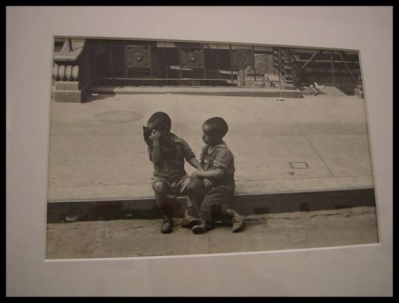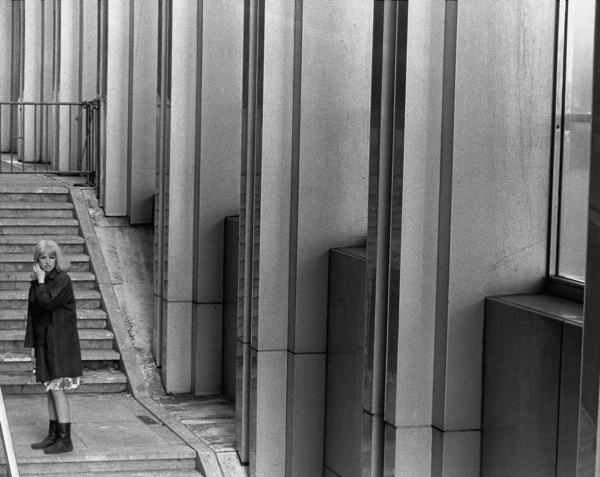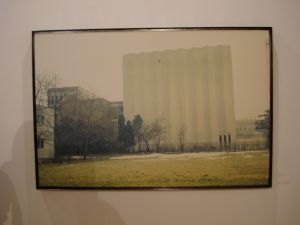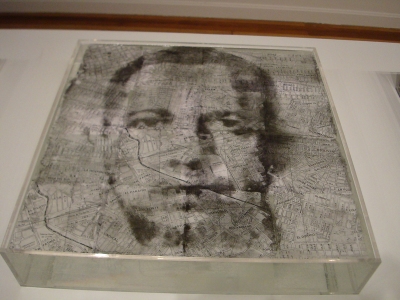theartsdesk in Madrid: City of Photography | reviews, news & interviews
theartsdesk in Madrid: City of Photography
theartsdesk in Madrid: City of Photography
The world's photographers descend on PhotoEspaña for a phenomenal feast
International photography festivals are rivalling rock festivals this summer - and rock festivals are featuring photographers. PhotoEspaña (PHE) Madrid beats the lot. Packed with surprise revelations, with central Madrid as the main stage, the fringe all around it, and the whole city involved in the Night of Photography PhotoMaratón, it’s a highly ambitious, even labyrinthine affair.
 PHE is known for its almost impossible amount of images to view, let alone absorb in a few days. By the end of a week, my dreams were scrambling Helen Levitt’s children playing in Harlem’s streets in the 1930s (pictured right), Harold Edgerton’s bullet frozen mid-flight through an apple, Isabel Munoz’s astonishing El Amor y El Extasis (Love and Ecstasy, see main image above), portraits of Kurdish Sufis lost in bloodied trances and meditational "whirling", and the sadness of young women doing time in an Argentine prison documented by Adriana Lestido.
PHE is known for its almost impossible amount of images to view, let alone absorb in a few days. By the end of a week, my dreams were scrambling Helen Levitt’s children playing in Harlem’s streets in the 1930s (pictured right), Harold Edgerton’s bullet frozen mid-flight through an apple, Isabel Munoz’s astonishing El Amor y El Extasis (Love and Ecstasy, see main image above), portraits of Kurdish Sufis lost in bloodied trances and meditational "whirling", and the sadness of young women doing time in an Argentine prison documented by Adriana Lestido.
Time is the theme of this year’s festival, chosen by the General Curator Sergio Mah, and an interestingly rich subject to navigate. It is, of course, crucial in analogue photography: producing photographs is dependent on F-stops, timers and exposure lengths, and the darkroom’s magic depends on a clock. The very process of taking a photograph freezes time. And archives, precious preservers of time periods, are central to PHE’s annual programmes.
The selected collections honour photographers who preserved both a time and a location. Levitt’s City Lyrics, 1939-91 (through to 29 August) is dedicated to the social choreography of Harlem’s children at play or making mischief and adults hanging out or working. Their naturalness was aided by the right-angled lens attachment which makes subjects unaware of her aim; she treats them not as "other" but as fellow citizens in a neighbourhood rarely visited by whites.
Within Levitt’s time-frame (and also running to 29 August), the multimedia Hungarian artist Lásló Maholy-Nagy is represented in a magnificent, vast body of paintings, collages, photographs, photograms and films inspired by the literal translation of photography as “writing with light.” As part of his 1920s experiments with his theory on Art of Light, it time-travels through Surrealism and Constructivism in Paris and London, to Bauhaus Modernism in New York and coincides with work at MIT by the scientist and electronics researcher Harold Edgerton who swung between technology and art. His stroboscopic light machine freezes motion at high speeds, allowing us to see movements the human eye naturally can’t - most beautifully, multiple tennis balls arcing away from a racket, images which Eadweard Muybridge could only have dreamt of.
 The festival’s largest collection, holds over 400 images: Manhattan: Mixed Use (to 27 September) is a long stroll through 1970s Lower Manhattan while it decayed as a port and industrial district before turning into the Financial District. It was already a haven for visual artists, with the Pier Project residents enacting river-related themes, Cindy Sherman posing against a high office building for a college study (picture left), and the gay scene’s furtively erotic stories indulged by Warhol protégé, Peter Hujar. Everywhere, light and shade, shadows and surfaces reflect changing times.
The festival’s largest collection, holds over 400 images: Manhattan: Mixed Use (to 27 September) is a long stroll through 1970s Lower Manhattan while it decayed as a port and industrial district before turning into the Financial District. It was already a haven for visual artists, with the Pier Project residents enacting river-related themes, Cindy Sherman posing against a high office building for a college study (picture left), and the gay scene’s furtively erotic stories indulged by Warhol protégé, Peter Hujar. Everywhere, light and shade, shadows and surfaces reflect changing times.
Madrid is PHE’s centrepiece but there are annexes in Lisbon and in the legendary artists’ town of Cuenca. This year, Cuenca focused on young, emerging Eastern bloc photographers working to themes around architecture. My favourite, Nico Ilfoneanu, used a box camera, long exposures and a laborious technique involving untreated colour film to make SteamPunk Autochromes which transform ugly Soviet tower blocks into ghostly buildings emerging from the industrial landscape, and turn raw childhood memories into idyllic, painterly scenes.
 Cuenca’s annual archive show, Batalla de Sombras (Battle of Shadows) from Lisbon’s National Museum, were taken during the Fifties fascist regime, and document the "dark" decades when amateur and professional photographers explored techniques, created surrealist abstracts, and strove to avoid controversy. Their sensitivity towards their subjects links them to contemporaries like Cartier-Bresson, similarly drawn to the documenting societies.
Cuenca’s annual archive show, Batalla de Sombras (Battle of Shadows) from Lisbon’s National Museum, were taken during the Fifties fascist regime, and document the "dark" decades when amateur and professional photographers explored techniques, created surrealist abstracts, and strove to avoid controversy. Their sensitivity towards their subjects links them to contemporaries like Cartier-Bresson, similarly drawn to the documenting societies.
The exhibition also hooks into modern Spain’s times of repression, through the controversial artist Fernando Sánchez Castillo. Compelled by the iconography of the General, Castillo froze that era in a multi-media documentary around the civic statuary "hidden" - stored - for 34 years since Franco’s death. His Táctica project brought blind people who never saw the dictator in person, to life-sized sculptures of him seated on his horse. Photographs show them touching the lips and face of the man who deeply affected their family’s lives, private tactile moments when time and memory meet in a healing process - and humiliate the Dictator.
 PHE’s growing relationship with its former Latin American colonies is now represented through the group of hand-picked young photographers subitted to the Encumbrimientos, whose films poetically depict the social reality of street life, and Guatemala’s Andrea Aragón, whose Super-Rubias (Super blondes) portraits document the pressure on women to become blonde. The 2010 winners exhibited include the Brazilian conceptual collective CIA de Foto.
PHE’s growing relationship with its former Latin American colonies is now represented through the group of hand-picked young photographers subitted to the Encumbrimientos, whose films poetically depict the social reality of street life, and Guatemala’s Andrea Aragón, whose Super-Rubias (Super blondes) portraits document the pressure on women to become blonde. The 2010 winners exhibited include the Brazilian conceptual collective CIA de Foto.
Of the Latino professionals, the best-known artist is Colombia’s Oscar Muñoz (picture left). His imaginative, layered, photographic installations include Becoming Air, an exploration of themes of ephemeral time and memory through a beautiful sequence of self-portraits drawn with water on a hot Bogota pavement. As the water evaporates, they disappear and are repeated over and over, fading and appearing, marking the passing of time and life - but also, surely, planned to evoke the faces of “disappeared” Latin-American political prisoners.
Back home, I received regular press releases and phone calls about glitzy award ceremonies and new events in the festival. Many of the smaller shows shut at the weekend, leaving the substantial, town-centre ones running till end of August or September. The highest prize of the year was given to the revered Mexican documentary photographer, Graciela Iturbide, in celebration of her fou- decade career. London’s Vanessa Winship took the Discoveries prize for Sweet Nothings, poetic portraits of rural Turkish schoolgirls which has won her many awards internationally, and this time, offers her a solo exhibition in 2011.
Latin America plays an increasingly significant part in PHE’s diverse projects. With next year’s PhotoEspaña already under way, the announcement yesterday of the new General Curator, Gerardo Mosquera, is an exciting deviation from Europe. A Havana-based critic, curator and art historian, and founder of the Havana Biennial, Mosquera suggests exciting and probably challenging possibilities. Employing a Cuban national also reflects the organization’s adventurousness and its commitment to linking Spain’s (and therefore Europe’s) photographic community with its former colonies, an inconceivable act even 20 years ago.
But in real time 2010, Madrid maintains continuity through to spring 2011 with exhibitions and mini-festivals. And between October and December, the Transátlantica opens in Colombia, Guatemala, Mexico and Uruguay. A record 708,000 visitors to this summer’s PhotoEspaña will take some beating.
- PhotoEspana Madrid runs through to 24 September at various sites
more Visual arts
 Fantastic Machine review - photography's story from one camera to 45 billion
Love it or hate it, the photographic image has ensnared us all
Fantastic Machine review - photography's story from one camera to 45 billion
Love it or hate it, the photographic image has ensnared us all
 Yinka Shonibare: Suspended States, Serpentine Gallery review - pure delight
Weighty subject matter treated with the lightest of touch
Yinka Shonibare: Suspended States, Serpentine Gallery review - pure delight
Weighty subject matter treated with the lightest of touch
 Jane Harris: Ellipse, Frac Nouvelle-Aquitaine MÉCA, Bordeaux review - ovals to the fore
Persistence and conviction in the works of the late English painter
Jane Harris: Ellipse, Frac Nouvelle-Aquitaine MÉCA, Bordeaux review - ovals to the fore
Persistence and conviction in the works of the late English painter
 Sargent and Fashion, Tate Britain review - portraiture as a performance
London’s elite posing dressed up to the nines
Sargent and Fashion, Tate Britain review - portraiture as a performance
London’s elite posing dressed up to the nines
 Zineb Sedira: Dreams Have No Titles, Whitechapel Gallery review - a disorientating mix of fact and fiction
An exhibition that begs the question 'What and where is home?'
Zineb Sedira: Dreams Have No Titles, Whitechapel Gallery review - a disorientating mix of fact and fiction
An exhibition that begs the question 'What and where is home?'
 Yoko Ono: Music of the Mind, Tate Modern review - a fitting celebration of the early years
Acknowledgement as a major avant garde artist comes at 90
Yoko Ono: Music of the Mind, Tate Modern review - a fitting celebration of the early years
Acknowledgement as a major avant garde artist comes at 90
 Unravel: The Power and Politics of Textiles in Art, Barbican review - the fabric of dissent
An ambitious exploration of a neglected medium
Unravel: The Power and Politics of Textiles in Art, Barbican review - the fabric of dissent
An ambitious exploration of a neglected medium
 When Forms Come Alive, Hayward Gallery review - how to reduce good art to family fun
Seriously good sculptures presented as little more than playthings or jokes
When Forms Come Alive, Hayward Gallery review - how to reduce good art to family fun
Seriously good sculptures presented as little more than playthings or jokes
 Entangled Pasts 1768-now, Royal Academy review - an institution exploring its racist past
After a long, slow journey from invisibility to agency, black people finally get a look in
Entangled Pasts 1768-now, Royal Academy review - an institution exploring its racist past
After a long, slow journey from invisibility to agency, black people finally get a look in
 Barbara Kruger, Serpentine Gallery review - clever, funny and chilling installations
Exploring the lies, deceptions and hyperbole used to cajole, bully and manipulate us
Barbara Kruger, Serpentine Gallery review - clever, funny and chilling installations
Exploring the lies, deceptions and hyperbole used to cajole, bully and manipulate us
 Richard Dorment: Warhol After Warhol review - beyond criticism
A venerable art critic reflects on the darkest hearts of our aesthetic market
Richard Dorment: Warhol After Warhol review - beyond criticism
A venerable art critic reflects on the darkest hearts of our aesthetic market
 Dineo Seshee Raisibe Bopape: (ka) pheko ye / the dream to come, Kiasma, Helsinki review - psychic archaeology
The South African artist evokes the Finnish landscape in a multisensory installation
Dineo Seshee Raisibe Bopape: (ka) pheko ye / the dream to come, Kiasma, Helsinki review - psychic archaeology
The South African artist evokes the Finnish landscape in a multisensory installation

Add comment